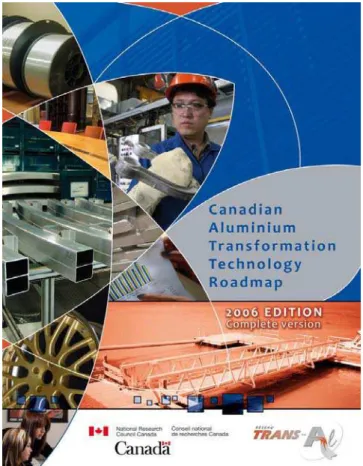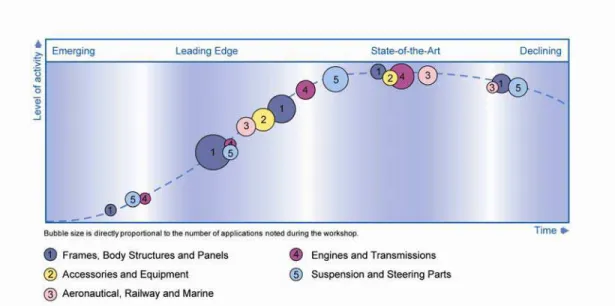Publisher’s version / Version de l'éditeur:
Light Metal Age Magazine, 65, 3, 2007-06-30
READ THESE TERMS AND CONDITIONS CAREFULLY BEFORE USING THIS WEBSITE.
https://nrc-publications.canada.ca/eng/copyright
Vous avez des questions? Nous pouvons vous aider. Pour communiquer directement avec un auteur, consultez la première page de la revue dans laquelle son article a été publié afin de trouver ses coordonnées. Si vous n’arrivez pas à les repérer, communiquez avec nous à PublicationsArchive-ArchivesPublications@nrc-cnrc.gc.ca.
Questions? Contact the NRC Publications Archive team at
PublicationsArchive-ArchivesPublications@nrc-cnrc.gc.ca. If you wish to email the authors directly, please see the first page of the publication for their contact information.
NRC Publications Archive
Archives des publications du CNRC
This publication could be one of several versions: author’s original, accepted manuscript or the publisher’s version. / La version de cette publication peut être l’une des suivantes : la version prépublication de l’auteur, la version acceptée du manuscrit ou la version de l’éditeur.
Access and use of this website and the material on it are subject to the Terms and Conditions set forth at
1st technology roadmap on aluminum transformation now available!
Simard, Alain; Pouliot, Jean-François
https://publications-cnrc.canada.ca/fra/droits
L’accès à ce site Web et l’utilisation de son contenu sont assujettis aux conditions présentées dans le site LISEZ CES CONDITIONS ATTENTIVEMENT AVANT D’UTILISER CE SITE WEB.
NRC Publications Record / Notice d'Archives des publications de CNRC:
https://nrc-publications.canada.ca/eng/view/object/?id=da5b8788-b318-45ab-811d-8981e58d5cf3 https://publications-cnrc.canada.ca/fra/voir/objet/?id=da5b8788-b318-45ab-811d-8981e58d5cf31
stTechnology Roadmap on aluminum transformation now available!
Introduction:
For the first time, a technology roadmap is available on aluminum transformation and is offered to everyone to read. www.trans-al.com/en
Several roadmaps have been published in previous years starting with the first one by the Aluminum Association in 1997 soon followed by the Canadian Aluminum Roadmap in 2000. However, all those roadmaps had one thing in common; their focus was on aluminum production process leaving the many small and medium transformers and fabricators in the shadow of the large multi-nationals.
In 2002, National Research Council Canada ( www.NRC-CNRC.gc.ca) began the construction of a state-of-the-art research centre whose main task is to be a catalyst for the emerging aluminum cluster in Eastern Canada. The centre also provides numerous support services to cluster members seeking for the most cost-effective ways for various types of industries to transform aluminum into durable, lightweight products. Furthermore, to ensure the technology cluster focuses on the objectives that are the most likely to be successfully achieved and generate the highest payoffs, NRC has designed a strategic plan aiming to develop two major areas of the transformation industry; advanced forming technologies and joining technologies. In early 2005, NRC teamed-up with Trans-Al Network in order to complete the first technology roadmap on aluminum transformation in the world. Trans-Al Network is an association of SME in the field of aluminum
transformation in the province of Quebec.
Although it presents the Canadian perspective on aluminum transformation, readers from all over the world will
recognize the same issues and concerns when it comes to transforming the silvery metal.
The following article presents a summary of the Canadian Aluminum Transformation Technology Roadmap - 2006 Edition.
Situation:
The relative importance of Canada as a primary producer is decreasing in spite of increased production. This can be explained by massive production growth in countries such as China. The situation is the same for semi-finished products. In the next few years, we will lose our position as the world’s 10th largest producer of rolled products. Meanwhile, we are importing more extruded products from overseas while only maintaining the status quo with respect to the production of shape castings, without necessarily being a major player.
The North American aluminum industry is largely vertically integrated, with the manufacturing chain distributed between Canada, the United States and even subsidiary operations in Europe. Thus Canada imports much of its semi-finished aluminum products despite its large primary metal production.
In order to resist the progressive leakage of finished product manufacturing to emerging economies, Canadian manufacturers are encouraged to invest in leading-edge design and manufacturing technologies rather than attempting to defend mature methods. Advanced modeling design techniques and fully-automated manufacturing, combined with a full awareness the capabilities of aluminum will facilitate customer acceptance and even preference for aluminum.
Figure 2: Canadian Production of Aluminum 2000-2005 Figure 3: American Production of Aluminum 2000-2005
Market:
In tandem with the rise of worldwide production, aluminum consumption will grow significantly all over the world in the next ten years. By 2015, Asia is expected to consume twice as much aluminum as North America. These facts could mean an interesting windfall for the Canadian aluminum transformation industry. A prodigious array of possibilities will be distributed among markets.
Figure 3: Evolution of World Consumption by Market Type 1995-2015
Source: James F. King
Depending on social choices, the growth of aluminum consumption in the transport industry will be between 20% and 70% in North America. In any case, synergy is necessary to better control the technologies that allow us to develop winning applications, and greater potential for the creation of wealth. Several emerging and growing technologies now need a multi-material and systems approach to achieve increased usage. It is, therefore, necessary to develop an understanding of the mechanisms of material combinations and favor designer training. This would allow the Canadian industry to seize a multitude of opportunities that would be applicable in diverse markets.
The construction industry is continuing to expand. Over the next 10 years, a growth of 58% on the Asiatic continent should take place, with a comparative rate of 20% for Europe and North America. The lack of promotion and information to the public limits the introduction of a number of emerging and leading edge applications. The competitiveness of aluminum must be enhanced so that winning strategies in our own and world-wide niches can be deployed. This can be accomplished at several levels, whether taking advantage of systems approach, life-cycle analysis or through the combination of multiple materials.
Figure 4: Life Cycle of Aluminum Applications in the Transportation Industry
Technology:
At the level of technology platforms, the needs for the aluminum transformation industry are striking. With the aid of state-of-the-art technologies, developing countries are gaining ground in the shape casting and forming sectors. Soon, these countries will do the same for products requiring leading edge and leading edge technologies, and the technological gap will be reduced ushering in fierce competition. Methods and techniques on aluminum-joining must be better deployed in Canadian industries. Methods respecting the environment and health of workers have also been called for in the surface treatment industry. Furthermore, offering surface treated alloys with improved properties could open the door to new niche markets. Promotion for machining and training support for new machining equipments and processes would revitalize this technology platform.
The most important technical issues are a) the development of new aluminum products having superior performance, produced using more efficient processes and b) better access to predictive and actual product performance testing facilities so as to meet the most demanding needs of the transportation, construction and energy industries.
Figure 5: Life Cycle of Technology in the Forming Industry
Social and Economic Factors:
Canada currently possesses knowledge at the most recent and advanced technological level and must continue to count on this technology. Nonetheless, it is necessary to consider human-based issues such as knowledge acquisition and training to be able to stay at the forefront of the industry. A rapid deployment of new production capacities will help ensure we remain competitive.
Canadian industry should immediately get together to rise up to the challenge. It is a bold commitment but a doable one. For example, technology deployment activities or collaborative R&D could well reduce risks and allow for optimal usage of equipment and resources.
According to specialists in workshops, several opportunities for successful aluminum promotion might be missed if support organizations and other institutions do not collaborate and cooperate amongst themselves. Systematic coordination of these collaborations, which is seen to be lacking at the moment, along with an actual commitment to work together is of the utmost importance to ensure the greater good.
Figure 6: NRC’s model for technology Cluster
Results:
From these observations come four recommendations that will allow the Canadian industry to consolidate its position. Thirty-eight needs and opportunities were also selected for their potential to create wealth, reasonable time frames and achievable technical challenges. Appropriation of these recommendations and opportunities by the stakeholders of the aluminum transformation field will allow Canada to step into a leading position.
Opportunities:
Industry experts analyzed the thirty-eight opportunities listed below and provided clear and concise summaries for each of them. Moreover, the benefits most likely to be generated by these opportunities are also presented in this document. The following opportunities were found to be particularly relevant:
1. Offer integrated aluminum solutions to OEM manufacturers 2. Develop multi-material solutions
Transp
ortati
on 3. Research & Develop alloys with higher strength and heat resistance for diesel engine
4. Research & Develop high formability, low cost, high strength aluminum alloys 5. Design lighter structures for trucks, buses, and recreational vehicles
6. Invent methods to produce larger castings with thinner walls
7. Achieve a significant cost reduction for the various aluminum transformation processes 8. Improve wear resistance, tribology and lubrication of aluminum surface
Cons
tru
ctio
n
9. Upgrade aging civilian infrastructures
10. Offer modular structures for easy on-site assembling 11. Offer large extruded shapes
12. Develop integrated design software for aluminum 13. Offer an Aluminum Design Solutions Centre
14. Perform alloy development for semi-solid rheocasting of structural components
Shape
Casti
ng
15. Develop a ‘‘Best Practice Guide for Shape Casting’’ 16. Offer aluminum Casting Competitiveness Tools
17. Make products from readily available liquid alloys from Canadian primary plants 18. Offer non-competitive process optimization
19. Improve real-time monitoring of products and processes with advanced sensors and systems 20. Improve and diffuse energy efficiency solutions for foundries
21. Offer larger castings with thinner walls
22. Create an aluminum life cycle cost/benefit body of knowledge
Forming
23. Design Aluminum multi-material flat panels 24. Research & Develop aluminum hydroforming 25. Improve process simulation of forming technologies 26. Invent new forming processes suitable to industry needs
Joining
27. Develop a body of knowledge on adhesives
28. Form an interest group on friction stir welding of aluminum
29. Develop or adapt sensing technologies for aluminum surface characterization
30. Offer prepainted sheet products capable of surviving forming operations 31. Develop chrome-free conversion treatment
Surfac
e
Treatment
32. Offer low-cost, decorative metal texturing
33. Develop a paint that can be applied to aluminum substrate without using conversion films 34. Research & develop a treatment to prevent the adhesion of ice to aluminum surfaces
Machining
35. Form an interest group on aluminum machining
36. Automate measurement systems to optimize part positioning and enhance equipment performance 37. Promote adoption of aluminum dry machining or MQL (Minimum Quantity Lubrication)
Recommendations:
The information put forth by the many industry players that took part in TRM surveys, workshop plenary assemblies, and follow-up activities have lead to the following four recommendations:
1. Ensure a systematic coordination and cooperation of all aluminum transformation industry players.
2. Develop the Canadian capacity to designing for aluminum instead of simply manufacturing out of aluminum. 3. Promote continuous training in the aluminum industry (architects, engineers, and designers).
4. Update the Canadian Aluminum Transformation Technology Roadmap.
Figure 7: Participant at the Transport Workshop in April 2006, Hamilton, Canada
or more information or to download the document, go to: www.trans-al.com/en





